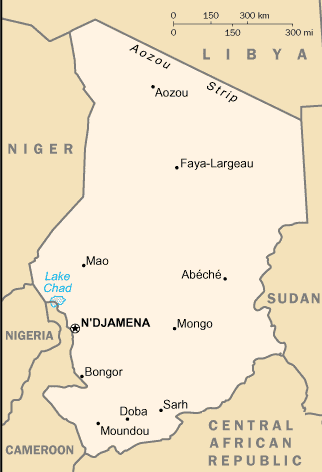
|

Chad
Background:
Chad, part of France's African holdings until 1960, endured three
decades of ethnic warfare as well as invasions by Libya before a semblance of
peace was finally restored in 1990. The government eventually suppressed or
came to terms with most political-military groups, settled a territorial
dispute with Libya on terms favorable to Chad, drafted a democratic
constitution, and held multiparty presidential and National Assembly elections
in 1996 and 1997 respectively. In 1998 a new rebellion broke out in northern
Chad, which continued to escalate throughout 2000. A peace agreement, signed in
January 2002 between the government and the rebels, provides for the
demobilization of the rebels and their reintegration into the political system.
Location:
Central Africa, south of Libya.
Area: Total: 1.284 million sq km water: 24,800 sq km land: 1,259,200 sq km
Area - comparative: Slightly more than three times the size of California.
Land boundaries: Total: 5,968 km. border countries: Cameroon 1,094 km, Central
African Republic 1,197 km, Libya 1,055 km, Niger 1,175 km, Nigeria 87 km, Sudan
1,360 km.
Climate and Terrain:
Climate: Tropical in south, desert in north.
Terrain: Broad, arid plains in center, desert in north, mountains in northwest,
lowlands in south.
Elevation extremes: Lowest point: Djourab Depression 160 m highest point: Emi
Koussi 3,415 m.
Natural resources: Petroleum (unexploited but exploration under way), uranium,
natron, kaolin, fish (Lake Chad).
Land use: Arable land: 3% permanent crops: 0% other: 97%.
People:
Population: 8,997,237.
Ethnic groups: 200 distinct groups; in the north and center: about 1,000 French
citizens live in Chad.
Religions: Muslim 51%, Christian 35%, animist 7%, other 7%.
Languages: French (official), Arabic (official), Sara (in south), more than 120
different languages and dialects.
Government:
Government type: Republic.
Capital: N'Djamena.
Independence: 11 August 1960 (from France).
Economy overview:
Chad's primarily agricultural economy will be boosted by
major oilfield and pipeline projects that began in 2000. Over 80% of Chad's
population relies on subsistence farming and stock raising for their
livelihood. Cotton, cattle, and gum arabic provide the bulk of Chad's export
earnings, but Chad will begin to export oil in 2004. Chad's economy has long
been handicapped by its land-locked position, high energy costs, and a history
of instability.
Statistics:
Telephones - main lines in use: 10,260.
Telephones - mobile cellular: 20,000.
Radio broadcast stations: AM 2, FM 3, shortwave 5.
Radios: 1.67 million.
Television broadcast stations: 1.
Televisions: 10,000.
Internet users: 1,000.
Railways: 0 km.
Highways: Total: 33,400 km paved: 450 km note: probably no more than 8,000 km
of the total receive maintenance, the remainder being desert tracks (2000)
unpaved: 32,950 km.
Waterways: 2,000 km
Airports - with paved runways: Total: 7.
Airports - with unpaved runways: Total: 42.
Return to Visiting Locations
|

